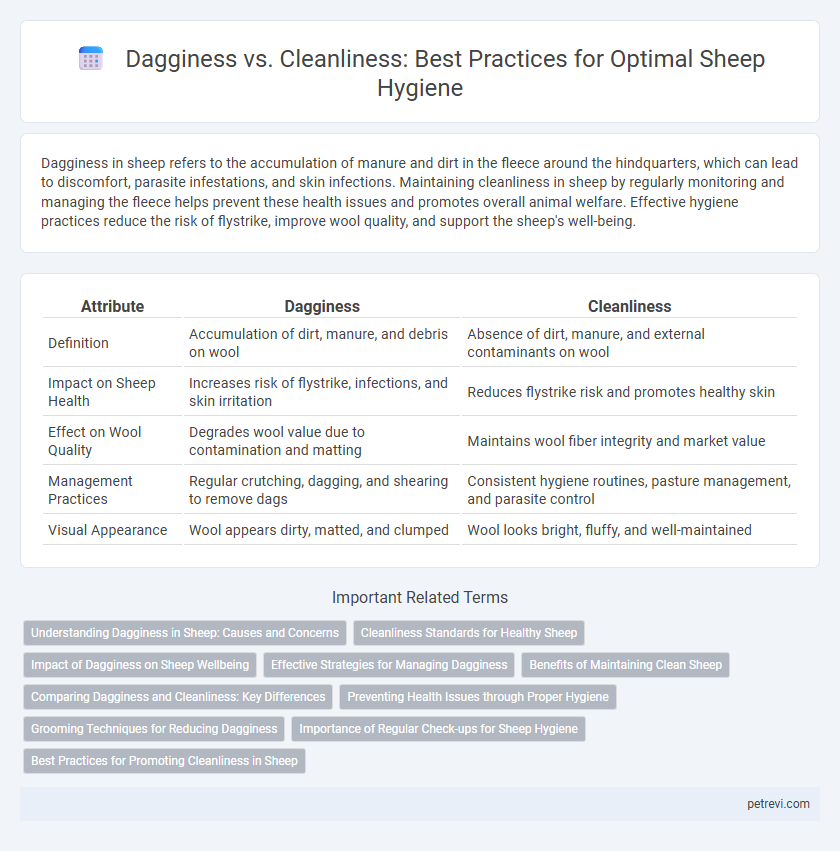Dagginess in sheep refers to the accumulation of manure and dirt in the fleece around the hindquarters, which can lead to discomfort, parasite infestations, and skin infections. Maintaining cleanliness in sheep by regularly monitoring and managing the fleece helps prevent these health issues and promotes overall animal welfare. Effective hygiene practices reduce the risk of flystrike, improve wool quality, and support the sheep's well-being.
Table of Comparison
| Attribute | Dagginess | Cleanliness |
|---|---|---|
| Definition | Accumulation of dirt, manure, and debris on wool | Absence of dirt, manure, and external contaminants on wool |
| Impact on Sheep Health | Increases risk of flystrike, infections, and skin irritation | Reduces flystrike risk and promotes healthy skin |
| Effect on Wool Quality | Degrades wool value due to contamination and matting | Maintains wool fiber integrity and market value |
| Management Practices | Regular crutching, dagging, and shearing to remove dags | Consistent hygiene routines, pasture management, and parasite control |
| Visual Appearance | Wool appears dirty, matted, and clumped | Wool looks bright, fluffy, and well-maintained |
Understanding Dagginess in Sheep: Causes and Concerns
Dagginess in sheep refers to the accumulation of mud, feces, and urine around the wool, especially near the rear, which can lead to hygiene issues and increased risk of flystrike, a serious parasitic infestation. Causes of dagginess include wet weather, poor pasture conditions, and inadequate shearing or crutching practices that fail to remove soiled wool. Maintaining cleanliness through regular crutching, monitoring environmental factors, and managing grazing conditions is essential to prevent health problems and promote overall sheep welfare.
Cleanliness Standards for Healthy Sheep
Maintaining high cleanliness standards is essential for healthy sheep, as it reduces the risk of infections and promotes overall well-being. Regular shearing and proper grooming prevent excessive dagginess, which can harbor bacteria and parasites, leading to wool rot and flystrike. Clean, well-maintained fleece supports better skin health and enhances the quality of wool production.
Impact of Dagginess on Sheep Wellbeing
Dagginess significantly affects sheep wellbeing by increasing the risk of flystrike, skin infections, and discomfort due to accumulated dirt and moisture. Maintaining cleanliness reduces parasite infestations and promotes healthier wool growth, directly improving animal welfare. Effective management practices focus on regular shearing and hygiene to minimize dag formation and enhance overall sheep health.
Effective Strategies for Managing Dagginess
Dagginess in sheep, characterized by matted wool and accumulated dirt around the tail and hindquarters, significantly impacts overall hygiene and health by increasing the risk of flystrike and infections. Effective strategies for managing dagginess include regular crutching, which removes wool from problem areas, and nutritional adjustments to reduce excessive wool growth and fecal contamination. Implementing timely shearing schedules combined with maintaining clean pasture conditions enhances cleanliness and prevents the buildup of dags, promoting better welfare and productivity in sheep flocks.
Benefits of Maintaining Clean Sheep
Maintaining clean sheep significantly reduces the risk of parasitic infections, improves wool quality, and enhances overall animal health. Cleanliness helps prevent flystrike, a common and painful condition caused by flies laying eggs in dirty wool. Proper hygiene practices contribute to better weight gain, increased productivity, and reduced veterinary costs in sheep farming.
Comparing Dagginess and Cleanliness: Key Differences
Dagginess in sheep refers to the accumulation of dirt, feces, and debris on their wool, which can lead to increased risk of flystrike and skin infections. Cleanliness, on the other hand, indicates well-maintained fleece free from contaminants, promoting better animal health and fiber quality. Effective sheep hygiene management focuses on minimizing dagginess through regular shearing, crutching, and proper environmental conditions to maintain optimal cleanliness.
Preventing Health Issues through Proper Hygiene
Maintaining sheep hygiene by reducing dagginess is essential for preventing flystrike and other parasitic infestations that compromise flock health. Regular shearing, crutching, and proper nutrition minimize wool contamination and fecal buildup, significantly lowering disease risk. Cleanliness in sheep promotes better immune function and overall wellbeing, crucial for sustaining productive and healthy livestock.
Grooming Techniques for Reducing Dagginess
Effective grooming techniques for reducing dagginess in sheep include regular shearing and strategic crutching, which remove wool accumulations around the tail and hindquarters to prevent dirt and fecal matter buildup. Using specialized tools such as wool combs and brushes enhances cleanliness by detangling matted wool and promoting air circulation, reducing moisture retention. Maintaining a scheduled grooming routine directly improves sheep hygiene, decreases the risk of flystrike, and contributes to overall flock health and productivity.
Importance of Regular Check-ups for Sheep Hygiene
Regular check-ups are crucial for maintaining sheep hygiene by preventing excessive dagginess, which can harbor parasites and promote infections. Monitoring and managing cleanliness reduce flystrike risks, improve animal welfare, and enhance wool quality. Consistent inspections allow early detection of hygiene issues, enabling timely interventions that support overall flock health.
Best Practices for Promoting Cleanliness in Sheep
Maintaining sheep hygiene requires regular shearing to prevent excessive dagginess, which can harbor dirt, moisture, and parasites, increasing the risk of flystrike. Implementing controlled grazing and frequent inspection helps identify and remove dags promptly, enhancing overall cleanliness and animal health. Using antiseptic treatments and providing clean, dry bedding also supports optimal hygiene standards for sheep welfare.
Dagginess vs Cleanliness for Sheep Hygiene Infographic

 petrevi.com
petrevi.com